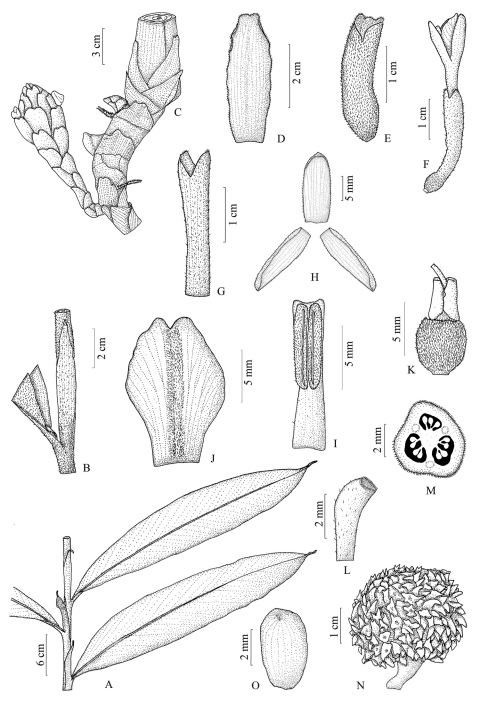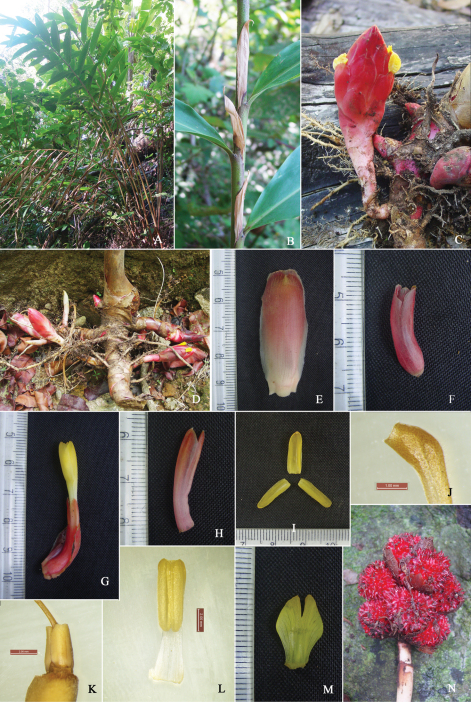Abstract Abstract
A new species of Amomum Roxb. from Western Ghats of Kerala is illustrated and described. Amomum nilgiricum VP.Thomas & M.Sabu, sp. nov. shows similarity with Amomum masticatorium Thwaites in having long drying ligule with an acuminate apex, pubescent anther and echinate capsules, but differs in clump forming habit with non-stoloniferous rhizomes, tomentose lamina beneath, long corolla tube, obovate to rhomboid labellum with clefted apex and without any colour design, emarginate anther crest and reduced staminodes. Detailed description, illustration, photographs, conservation status, and distributional details are provided.
Keywords: Amomum, Zingiberaceae, Western Ghats, Kerala, India
Introduction
Intensive botanical explorations for the revision of Indian Amomum have resulted in the collection of an interesting species with long membranous ligule from the Silent Valley National Park on the Western Ghats of Kerala. The family Zingiberaceae (ginger family) consists of 53 genera and over 1200 species (Kress et al. 2002). Amomum Roxb. is the second largest genus after Alpinia Roxb. within Zingiberaceae with about 150-180 species, widely distributed in Southeast Asia (Xia et al. 2004). In India the genus is represented by 22 species, mostly restricted to North-East India and South India (Thomas et al. 2010). Sabu (2006) reported 6 species of Amomum from South India and Thomas et al. (2009) raised the number species to 7 by reporting new distribution record of Amomum fulviceps Thwaites.
The new species, Amomum nilgiricum, shows similarity with Amomum masticatorium Thwaites in having long drying ligule with an acuminate apex, pubescent anther and echinate capsules, but differs in clump forming habit with non-stoloniferous rhizomes, tomentose lamina beneath, long corolla tube, obovate to rhomboid labellum with clefted apex, emarginate anther crest and reduced staminodes (Table 1). Amomum nilgiricum shows some morphological affinities with Amomum villosum group in the phylogenetic grouping of Xia et al. (2004).
Table 1.
Distinguishing morphological characters of Amomum masticatorium and Amomum nilgiricum
| Attributes | Amomum masticatorium | Amomum nilgiricum |
|---|---|---|
| Habit | slender, spreading | robust, clump forming |
| Rhizome | slender and stoloniferous | stout and non-stoloniferous |
| Lamina | oblong-lanceolate, 15−30 × 3−7.5 cm | lanceolate to elliptic-lanceolate, 32−41 × 6.5−8 cm |
| Petiole | 0−2 mm long | 2−8 mm long |
| Leaves | glabrous to puberulous beneath | tomentose beneath |
| Ligule | 2.5−4.5 cm long and half deciduous | 4.5−9 cm long and persistent |
| Corolla tube | shorter than labellum | longer than labellum |
| Labellum | 3−3.5 × 2.3−2.8 cm, trilobed, maroon stripes on yellow ground | 1.4−1.5 × 1−1.2 cm, not trilobed, uniformly yellow |
| Lateral staminodes | 2−5 mm long | absent |
| Stamen | 1.7−2.1 cm long, crest truncate, 1.5−1.6 × 0.3−0.4 cm | 1.1−1.2 cm long, crest emarginate, c. 0.3 × 0.1 cm |
Taxonomic affinities
Amomum nilgiricum
V.P. Thomas & M. Sabu sp. nov.
urn:lsid:ipni.org:names:77116671-1
http://species-id.net/wiki/Amomum_nilgiricum
Figure 1.
Amomum nilgiricum A a part of leafy shoot B ligule C inflorescence D bract E bracteole F flower G calyx H corolla lobes I stamen J labellum K ovary with epigynous glands and style L stigma M c.s. of ovary N fruit O seed.
Figure 2.
Amomum nilgiricum A habit B ligules C inflorescence D rhizome with inflorescences E bract F bracteole G flower with a bract H calyx I corolla lobes J stigma K ovary with epigynous glands and style L stamen M labellum N infructescence.
Diagnosis.
The species shows similarity with Amomum masticatorium Thwaites in having long drying ligule with an acuminate apex, pubescent anther and echinate capsules, but differs in clump forming habit with non-stoloniferous rhizomes, tomentose lamina beneath, long corolla tube, obovate to rhomboid labellum with clefted apex and without any colour design, emarginate anther crest and reduced staminodes.
Type.
INDIA. Kerala: Palakkad District, Silent Valley National Park, 1.5 km from Walakkad towards Sispara, 1200 m elevation, 3 April 2009, V.P. Thomas & M.C. Shameer 115574 (holotype: CALI; Isotype, MH, CAL).
Description.
Clump forming herb. Rhizome non-stoloniferous, stout, robust, 2−4 cm thick, robust, creamy-white inside, sheathed with scales; scales ovate to triangular, chartaceous, c. 1.8 × 2 cm, apex nearly rounded, pubescent externally. Leafy shoots 200−400 cm tall, robust, clump forming; sheath 2.5−4.5 cm wide at base, green, densely pubescent externally. Leaves 14−20 per leafy shoot; lamina lanceolate to elliptic-lanceolate, 32−41 × 6.5−8 cm, base cuneate, margin slightly straight, apex acuminate to 3 cm long, puberulous to glabrous and green on upper surface, tomentose and pale beneath; midrib hispid beneath; veins appressed above; petiole 2−8 mm long, pale green, wooly tomentose. Ligule entire, lanceolate, 4.5−9 cm long, chartaceous, drying, persistent, apex acute, pubescent to tomentose externally, glabrous within. Inflorescence 7−15 cm long, many flowered, arise from the rhizome under soil; peduncle 3.5−7.5 cm long. Bract oblong, 3−4.7 × 1.6−2.1 cm, coriaceous, red, margin ciliate, apex slightly emarginate, pubescent externally, glabrous internally. Bracteole tubular, 2-lobed, 2.2−2.5 × 0.5−0.6 cm, unequally split, membranous, red, margin ciliate, apex acute, pubescent externally, glabrous within. Flower 4.7−5.2 cm long, yellow; pedicel 5 mm long. Calyx 2 or 3-lobed, 2.4−2.8 × 0.4 cm, pale red, membranous, split nearly equal, margin ciliate, apex acute, pubescent externally, glabrous within. Corolla tube 2.5−3 cm long, c. 4 mm wide at mouth, pale yellow, pubescent externally, glabrous internally except near mouth; dorsal corolla lobe oblong, 1.4−1.6 × 0.7−0.8 cm, yellow, margin ciliate, apex hooded, ecuspidate, pubescent externally, glabrous within; lateral corolla lobes oblong, 1.4−1.6 × 04−0.6 cm, yellow, margin ciliate, apex nearly rounded, one side slightly folded, pubescent outside, glabrous within. Labellum obovate to rhomboid, 1.4−1.5 × 1−1.2 cm, uniform yellow, margin entire, apex clefted, pubescent inside along the median part. Lateral staminodes absent. Stamen 1.1−1.2 cm long; filament 4−5 × 2.5−3 mm, pale yellow, broader towards base, rarely minutely pubescent; connective rarely pubescent externally; crest inconspicuous, c. 3 × 1 mm, yellow, apex emarginate, rarely puberulous; anther thecae oblong, 6−7 mm long, creamy-white, base nearly rounded, apex rounded, pubescent; dehiscing throughout their length. Epigynous glands 2, oblong, 3−4 mm long, cream coloured, apex truncate, rarely puberulous. Ovary globose, 4−5 × 4 mm, densely pubescent externally; locules 3; ovules many on axile placentae; style 3.4−3.7 cm long, pubescent towards tip, glabrous towards base; stigma, tubular, c. 1 mm across, pale yellow, mouth ciliate, opening terminal. Capsule 8−10 per spike, globose, 2−3 × 2−3 cm, red, echinate, spines stout, pubescent externally, calyx not persistent. Seeds many, slightly oblong, 4−5 × c. 3 mm, black, aromatic, arillate, glabrous; aril white.
Flowering and fruiting.
March−November.
Distribution.
Known only from type locality, Silent Valley National Park, Western Ghats, Kerala in the evergreen forest above 1210 m.
Etymology.
the specific epithet nilgiricum indicates the place of collection Nilgiri Hills, a part of Western Ghats.
Conservation status.
Critically endangered (CR B1ab(ii,iii)+B2ab(i,ii)). The taxon has been evaluated against the criteria as described in IUCN (2001). The area of occupancy is estimated to be less than 10 Km2 and its habitat is severely fragmented, and known to exist only in a single location. A continuous decline in quality of habitat and extent of occurrence is noticed. Major threat to the population are forest fire and clearing of trekking path in the forest which cause damage to the existing population.
Specimens examined.
INDIA, Kerala: Palakkad District, Silent Valley National Park, 3 km from Walakkad towards Sispara, 24 September 2008, V.P. Thomas & K.M. Prabhu Kumar 115504 (CALI); 2 km from Walakkad towards Sispara, 1 March 2009, V.P. Thomas & A.V. Prasanth 115540 (CALI).
Supplementary Material
Acknowledgements
We are thankful to the Department of Science and Technology, New Delhi, for financial support. The authors are grateful to Department of Forest, Govt. of Kerala for providing necessary forest permission. We are also thankful to Dr Mark Newman, RBG, Edinburgh for critical comments on the species. We are thankful to Mr Shameer MC Department of Botany University of Calicut for the helps during specimen collection.
References
- Kress WJ, Prince LM, Williams KJ. (2002) The phylogeny and new classification of the gingers (Zingiberaceae): Evidence from molecular data. American Journal of Botany 89 (11): 1682-1696 doi: 10.3732/ajb.89.10.1682 [DOI] [PubMed] [Google Scholar]
- Sabu M. (2006) Zingiberaceae and Costaceae of South India. Indian Association for Angiosperm Taxonomy, University of Calicut, Kerala.
- Thomas VP, Sanoj E, Sabu M, Prasanth AV. (2009) On the identity and occurrence of Amomum fulviceps Thwaites (Zingiberaceae) in India. Rheedea 19 (1&2): 13-17 [Google Scholar]
- Thomas VP, Dan M, Sabu M, Jabbar MA. (2010) Amomum andamanicum (Zingiberaceae): a new species from the Andaman Islands, India. Blumea 55: 295-299 doi: 10.3767/000651910X550954 [Google Scholar]
- Xia YM, Kress WJ, Prince LM. (2004) Phylogenetic analysis of Amomum (Alpinioideae: Zingiberaceae) using ITS and matK DNA sequence data. Systematic Botany 29 (2): 334-344 doi: 10.1600/036364404774195520 [Google Scholar]
Associated Data
This section collects any data citations, data availability statements, or supplementary materials included in this article.




